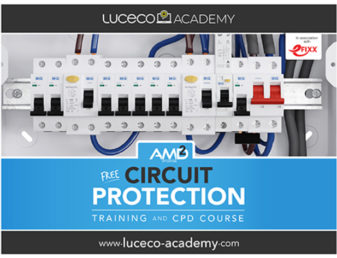Circuit protection, at its simplest, is the intentional addition of a ‘weak link’ in an electrical circuit. This link will be broken in the event of a fault – whether that’s high temperature, excessive current or a short circuit in a conductor, thus protecting the electrical circuit it’s part of from damage.
Why are circuit protective devices important?
Protective devices are important because they ensure that under fault conditions, a high fault current cannot flow – as well as protecting the installation this, more importantly, ensures that consumers are not injured or killed as a result of an electrical fault. Overcurrent protection is provided by circuit breakers or fuses which operate within specific limits, disconnecting the supply automatically when there is an overload or fault current (short circuit or earth fault). Overcurrent conditions arise from overloads or short circuits. An overload is a result of a faulty item, or too many items being connected to a circuit. A short circuit occurs when a live conductor comes into contact with an exposed conductive part, or another conductor in the circuit where is low or negligible impedance. This can be due to incorrectly connected wiring or damage to cables. Meanwhile, earth faults are similar to short circuits and occur when a live conductor comes into contact with an earthed conductor, exposed or extraneous conductive part. There does not need to be a high current flow in an earth fault.
It is essential that the appropriate circuit protection is installed ensure an electrical installation is safe.
Types of circuit protection
Fuse
A fuse contains a piece of wire that melts easily. If the current going through the fuse is too great, the wire heats up until it melts and breaks the circuit.
There are several different types of fuses:
- BS3036 rewirable fuses – these are used in domestic circuit protection and are cheap, easily repaired and easily checked to see if they’ve blown. However, they are not precise, can be abused by fitting incorrect fuse wire, and can contain dangerously hot metal.
- BS1361 / 1362 cartridge fuses – used in plug tops and distributions, cartridge fuses are fairly accurate, have a low fusing factor, are easily replaced and have no external arcing. However, they are more expensive than rewirable fuses, and it’s not possible to see by looking at them whether they’ve blown.
- BS 88 High Breaking Capacity Fuses (HBC) – these are used in industrial installations and motor circuits. They are fast operating, easily replaced, fairly accurate and have no external arcing. They are very expensive to replace.
Residual Current Device (RCD)
Residual Current Devices (or RCDs) are designed to detect and disconnect supply in the event of an earth fault, for example when a live conductor touches an earthed equipment case, or when a live conductor is cut through. This type of fault is potentially dangerous and can result in electric shocks and fires.
Miniature Circuit Breaker (MCB)
A Miniature Circuit Breaker is an electromechanical device designed to protect an electric circuit from overcurrent. MCBs are reusable where fuses are not. They are also much easier to use, with on/off switching for circuit isolation and are much safer as the conductor is housed within a plastic casing. There are much more expensive than fuses, and require regular testing. Ambient temperature also affects their performance.
A circuit breaker acts as a switch, and opens when excessive current flows in a circuit. It can be reset without damage and the main contacts are held closed by a latching mechanism. The latch can be tripped in two ways – thermally (when heat generated through excessive current would bend a metal strip to trip the breaker) or magnetically (when a fault current would strengthen the magnetic field to operate the latch).
MCBs do not protect humans against electric shocks caused by earth leakage – RCDs and RCBOs do this.
Residual Current Breaker with Overcurrent (RCBO)
A residual current breaker with overcurrent (RCBO) is used in applications where there is a need for combined protection against both overcurrents (overload and short circuit) and earth leakage current faults.






